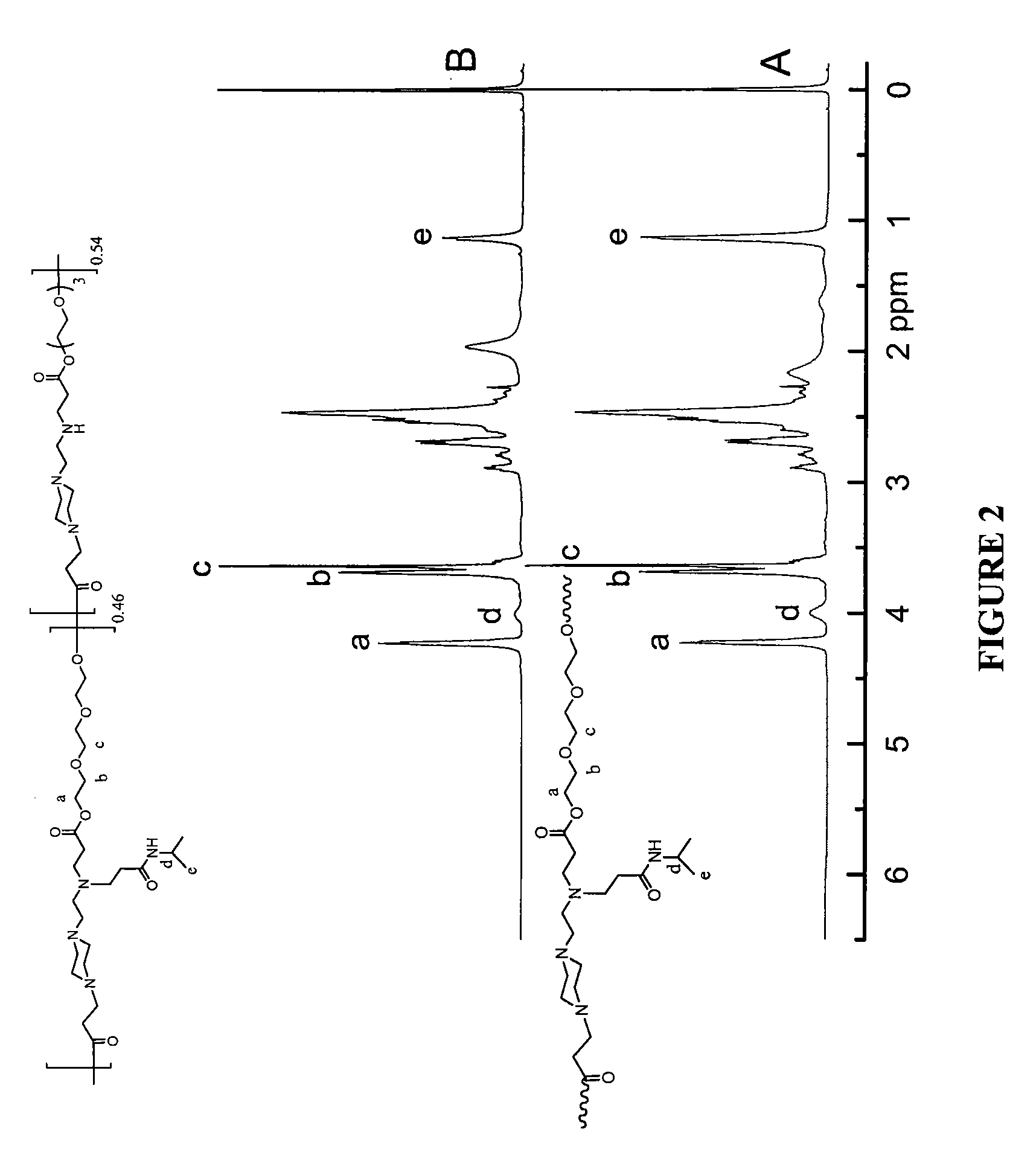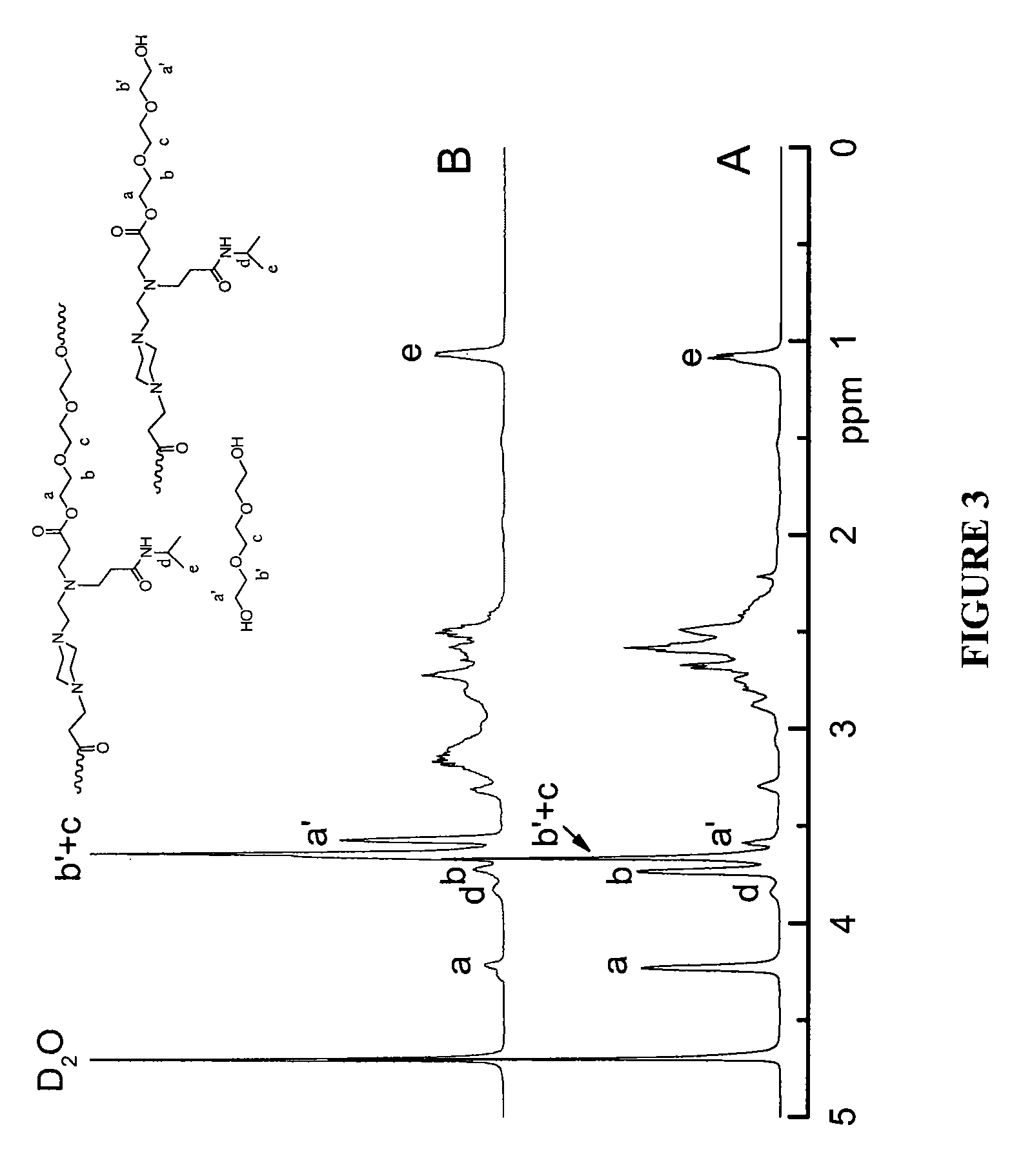Stimulus-responsive biodegradable polymers and methods of preparation
a biodegradable polymer and stimulus technology, applied in the direction of snake antigen ingredients, peptide/protein ingredients, pharmaceutical non-active ingredients, etc., can solve the problems of build-up in the body and the inability to biodegrade pnipaam
- Summary
- Abstract
- Description
- Claims
- Application Information
AI Technical Summary
Benefits of technology
Problems solved by technology
Method used
Image
Examples
example 1
Synthesis and Characterization of Linear Poly(Amino Ester)poly(PEG258DA-AEPZ)
[0229]AEPZ (11.6 mmol) was dissolved in 25 mL of dimethylsulfoxide (DMSO) at room temperature. PEG258DA (11.6 mmol) was added dropwise to the solution while stirring, followed by rinsing with 5 mL of DMSO. The mixture was stirred at room temperature for about 48 hours. 0.2 g of N-methyl piperazine (NMP) was added and kept stirring for 2 hours to seal end vinyl groups. The product was precipitated from the reaction using 200 mL of diethyl ether under vigorously stirring. The polymer was collected and purified by reprecipitation from a chloroform solution into diethyl ether followed by being dried under vacuum at 50° C. for 24 hours.
[0230]A water-soluble poly(amino ester) was obtained having an average molecular weight of 9900 g / mol with a wide molecular weight distribution index of 4.71 as determined by GPC.
example 2
Synthesis and Characterization of Stimulus-Responsive Polymer Poly(PEG258DA-AEPZ)-g-NIPAAm
[0231]In a 100 mL of round-bottomed flask, NIPAAm (23.2 or 17.4 mmol) was added into the solution of poly(PEG258DA-AEPZ) (11.6 mmol) in 30 mL of DMSO. The reaction was performed at 80° C. under argon protection for one week. After that, the solution was precipitated into 500 mL of diethyl ether, and the polymer was collected and purified by reprecipitation from a chloroform solution (10 mL) into mixture solutions containing 80 mL of hexane and 20 mL of toluene at 50° C., followed by being dried under vacuum at 50° C. for 24 hours.
[0232]The reaction could yield different graft degree of NIPAAm. As shown in FIG. 2, 1H NMR spectroscopy was performed to determine the graft degree from the ratio of integrated characteristic relative peaks. As seen in FIG. 2, there are two types of hydrogen ascribed to isopropyl group of NIPAAm, with peaks located at 4.0 ppm (1H, CH(CH3)2) and 1.1 ppm (6H, CH(CH3)2),...
example 3
Synthesis and Characterization of Stimulus-Responsive Stimulus-Degradable Polymer Poly(BAC / MBA-AEPZ)-g-NIPAAm
[0236]First, linear poly(BAC / MBA-AEPZ) containing secondary amines in the backbone was prepared. N,N′-Bis(acryloyl) cystamine (BAC, 1.915 mmol) and N,N′-methylene bisacrylamide (MBA, 1.915 mmol) were dissolved in a mixture solvent of 8 mL of methanol and 2 mL of pure water at room temperature. AEPZ (3.83 mmol) was added dropwise to the solution while stirring, followed by rinsing with 2 mL of methanol. The mixture was stirred at 50° C. for about 48 hours. 0.1 g of N-methyl piperazine (NMP) was added and kept stirring for 2 hours to seal end vinyl groups. The product was precipitated from the reaction using 100 mL of cool acetone under vigorously stirring. The polymer was collected and purified by reprecipitation from a methanol solution into cool acetone followed by being dried under vacuum at 50° C. for 24 hours.
[0237]In a 25 mL of round-bottomed flask, NIPAAm (7.66 mmol) wa...
PUM
| Property | Measurement | Unit |
|---|---|---|
| pH | aaaaa | aaaaa |
| critical solution temperature | aaaaa | aaaaa |
| pH | aaaaa | aaaaa |
Abstract
Description
Claims
Application Information
 Login to View More
Login to View More - R&D
- Intellectual Property
- Life Sciences
- Materials
- Tech Scout
- Unparalleled Data Quality
- Higher Quality Content
- 60% Fewer Hallucinations
Browse by: Latest US Patents, China's latest patents, Technical Efficacy Thesaurus, Application Domain, Technology Topic, Popular Technical Reports.
© 2025 PatSnap. All rights reserved.Legal|Privacy policy|Modern Slavery Act Transparency Statement|Sitemap|About US| Contact US: help@patsnap.com



